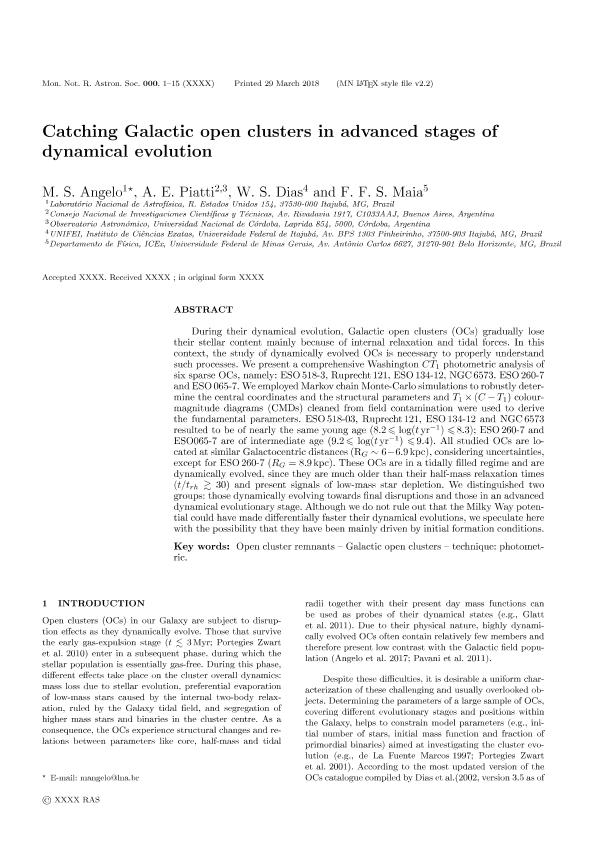Mostrar el registro sencillo del ítem
dc.contributor.author
Angelo, M.S.
dc.contributor.author
Piatti, Andres Eduardo

dc.contributor.author
Dias, W. S.
dc.contributor.author
Maia, F. F. S.
dc.date.available
2021-08-16T20:57:27Z
dc.date.issued
2018-07
dc.identifier.citation
Angelo, M.S.; Piatti, Andres Eduardo; Dias, W. S.; Maia, F. F. S.; Catching Galactic open clusters in advanced stages of dynamical evolution; Wiley Blackwell Publishing, Inc; Monthly Notices of the Royal Astronomical Society; 477; 3; 7-2018; 3600-3622
dc.identifier.issn
0035-8711
dc.identifier.uri
http://hdl.handle.net/11336/138311
dc.description.abstract
During their dynamical evolution, Galactic open clusters (OCs) gradually lose their stellar content mainly because of internal relaxation and tidal forces. In this context, the study of dynamically evolved OCs is necessary to properly understand such processes. We present a comprehensive Washington CT1 photometric analysis of six sparse OCs, namely ESO 518-3, Ruprecht 121, ESO 134-12, NGC6573, ESO 260-7, and ESO 065-7. We employed Markov chainMonte Carlo simulations to robustly determine the central coordinates and the structural parameters and T1 × (C - T1) colour-magnitude diagrams cleaned from field contamination were used to derive the fundamental parameters. ESO 518-03, Ruprecht 121, ESO 134-12, and NGC6573 resulted to be of nearly the same young age [8.2≤log(t yr-1) ≤8.3]; ESO 260-7 and ESO065-7 are of intermediate age [9.2≤log(t yr-1) ≤9.4]. All studied OCs are located at similar Galactocentric distances (RG ~6-6.9 kpc), considering uncertainties, except for ESO 260-7 (RG = 8.9 kpc). These OCs are in a tidally filled regime and are dynamically evolved, since they are much older than their half-mass relaxation times (t/trh ≳ 30) and present signals of low-mass star depletion. We distinguished two groups: those dynamically evolving towards final disruptions and those in an advanced dynamical evolutionary stage. Although we do not rule out that theMilkyWay potential could have made differentially faster their dynamical evolutions, we speculate here with the possibility that they have been mainly driven by initial formation conditions.
dc.format
application/pdf
dc.language.iso
eng
dc.publisher
Wiley Blackwell Publishing, Inc

dc.rights
info:eu-repo/semantics/openAccess
dc.rights.uri
https://creativecommons.org/licenses/by-nc-sa/2.5/ar/
dc.subject
OPEN CLUSTERS AND ASSOCIATIONS: GENERAL
dc.subject
TECHNIQUES: PHOTOMETRIC
dc.subject.classification
Otras Ciencias Naturales y Exactas

dc.subject.classification
Otras Ciencias Naturales y Exactas

dc.subject.classification
CIENCIAS NATURALES Y EXACTAS

dc.title
Catching Galactic open clusters in advanced stages of dynamical evolution
dc.type
info:eu-repo/semantics/article
dc.type
info:ar-repo/semantics/artículo
dc.type
info:eu-repo/semantics/publishedVersion
dc.date.updated
2021-07-30T18:13:12Z
dc.identifier.eissn
1365-2966
dc.journal.volume
477
dc.journal.number
3
dc.journal.pagination
3600-3622
dc.journal.pais
Reino Unido

dc.journal.ciudad
Londres
dc.description.fil
Fil: Angelo, M.S.. Laboratorio Nacional de Astrofísica Itajuba; Brasil
dc.description.fil
Fil: Piatti, Andres Eduardo. Consejo Nacional de Investigaciones Científicas y Técnicas; Argentina. Universidad Nacional de Córdoba. Observatorio Astronómico de Córdoba; Argentina
dc.description.fil
Fil: Dias, W. S.. Universidade Federal de Itajubá; Brasil
dc.description.fil
Fil: Maia, F. F. S.. Universidade Federal de Minas Gerais; Brasil
dc.journal.title
Monthly Notices of the Royal Astronomical Society

dc.relation.alternativeid
info:eu-repo/semantics/altIdentifier/url/https://academic.oup.com/mnras/article/477/3/3600/4963760
dc.relation.alternativeid
info:eu-repo/semantics/altIdentifier/doi/https://doi.org/10.1093/mnras/sty875
Archivos asociados
